


 |
Chung-ke Chang | |
| Postdoctoral Fellow PhD Carnegie Mellon University | ||
|
Telephone | +886 2 2789 9039 | |
| E-mail | chungke@ibms.sinica.edu.tw | |
|
Office |
Rm. N720 Institute of Biomedical Sciences No. 128, Sec. 2, Academy Road 11529 Taipei, Taiwan. |
| Biophysical and biochemical properties of the SARS-CoV nucleocapsid protein |
| Severe acute respiratory syndrome (SARS) is a recently emergent disease which attacks the respiratory tract. It is caused by a novel coronavirus, SARS-CoV, which has a single-stranded RNA genome of ca. 29 kbs. The genome is encapsulated by numerous copies of the nucleocapsid (N) protein into a helical capsid. The N protein is one of the most abundant viral proteins and is highly immunogenic; its entry into host cells ellicits a variety of responses including apoptosis and cell-death. Our group focuses on the study of the structure and its relationship to the biochemical activities of the protein. We are particularly interested in how the N protein structure facilitates RNA binding and genomic RNA packaging. |